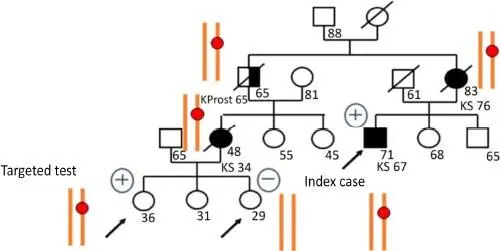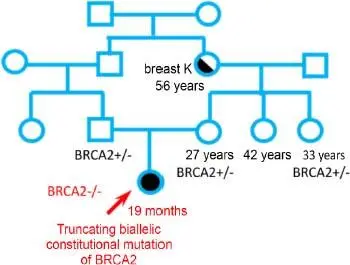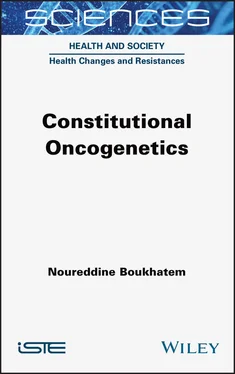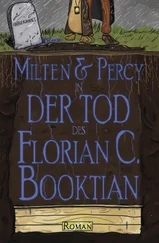– discussing the option of risk-reducing mastectomy: the counseling should include a discussion of the degree of protection, reconstruction options and risks. In addition, family history and residual risk of breast cancer with age and life expectancy should be considered during counseling;
– recommending risk reduction by offering prophylactic 14bilateral adnexectomy (PBA), usually between 35 and 40 years of age and at the end of maternity. For the management of ovarian cancer risk in patients with BRCA2 mutations, it is reasonable to delay PBA until 40-45 years of age (ovarian cancer development in patients with BRCA2 mutations is on average 8-10 years later than in patients with BRCA1 mutations):- guidance includes a discussion of reproductive desires, the extent of cancer risk, the degree of protection against breast and ovarian cancer, management of menopausal symptoms, possible short-term hormone replacement therapy and related medical issues,- bilateral adnexectomy alone is not the standard of care for risk reduction, although clinical trials of bilateral prophylactic interval adnexectomy and delayed oophorectomy are ongoing. The only concern with bilateral adnexectomy is that women are still at risk of developing ovarian cancer. In addition, in premenopausal women, oophorectomy probably reduces the risk of developing breast cancer, but the extent of this reduction is uncertain and depends on gene alteration;
– addressing the psychosocial, social and quality of life aspects of prophylactic bilateral mastectomy and adnexectomy.
For patients who have not chosen PBA, transvaginal ultrasound combined with serum CA-125 for ovarian cancer screening, although of uncertain benefit, may be considered from 30 to 35 years of age.
Appropriate medication (e.g. tamoxifen, raloxifene, anastrozole and exemestane) can almost halve the risk of developing hormone-positive breast cancer. The decision to use such a drug requires discussion of the relative benefits and potential risk of side effects in the context of a woman’s general health, menopausal status and reproductive plans. In addition, the use of PARP inhibitors (e.g. olaparib, niraparib and rucaparib) is a potentially lethal synthetic therapeutic strategy and can be considered as targeted chemoprevention in patients with specific defects in DNA repair including BRCA1/2 mutations.
DEFINITION.– The term mastectomy refers to the surgical removal of all or part of the breast and sometimes the associated lymph nodes and muscles .
DEFINITION.– The term bilateral adnexectomy refers to a surgical procedure that involves the removal of the fallopian tubes and ovaries on both sides of the reproductive organ .
DEFINITION.– The term prophylactic here refers to a medical act that tends to prevent or inhibit the spread or occurrence of a cancerous disease .
It is recommended to practice breast self-examination from the age of 35.
A clinical breast examination is recommended every 12 months from the age of 35 onwards.
From the age of 45, the recommendations are as follows:
– recommended prostate cancer screening for BRCA2 carriers;
– considered screening for prostate cancer in BRCA1 carriers.
People at risk need to be educated to recognize the signs and symptoms of cancer, particularly those associated with BRCA1/2 mutations.
There are no specific guidelines for screening for pancreatic cancer and melanoma, but screening can be individualized according to the cancer types observed in the family 16.
1.10.4. Risks to relatives
Relatives should be advised about the possible risks of hereditary cancer, options for risk assessment and management.
It is necessary to recommend genetic counseling and to consider genetic testing for at-risk relatives.

Figure 1.4. Identifying at-risk individuals in the family (by testing family members (adults) who wish to be tested to reassure non-carriers and monitor carriers). The targeted test in the 36-year-old female was positive and the test in the 29-year-old female was negative
1.10.5. Reproductive options
For patients of childbearing age, it is recommended to advise them on options for prenatal diagnosis and assisted human reproduction, including preimplantation genetic diagnosis. The discussion should include the known risks, limitations and benefits of these technologies.
Biallelic mutations in some genes, such as BRCA2 and some other genes included in gene panels, may be associated with rare autosomal recessive conditions. Thus, for these types of genes, partner testing for mutations in the same gene would be considered if it were to be used as a basis for reproductive decision making and/or risk assessment and management.

Figure 1.5. Fanconi disease: autosomal recessive transmission. Both parents are carriers of BRCA2 mutations. Medical history of the baby includes abnormalities of fetal development, small size, bone marrow dysplasia, Wilms’ tumor at 7 months, neuroblastoma at 11 months and medulloblastoma tumor at 19 months
DEFINITION.– Medulloblastoma is a rapidly growing type of cancer that forms in the cerebellum. Medulloblastoma tends to spread through cerebrospinal fluid to the spinal cord or other parts of the brain. It can also spread to other parts of the body, but this is rare. Medulloblastoma is more common in children and young adults. It is a type of embryonic tumor of the central nervous system .
DEFINITION.– Neuroblastoma is a type of cancer that develops from immature nerve cells. It usually begins in the adrenal glands, but can also start in the abdomen, chest or nerve-vessel tissues near the spine. Neuroblastoma occurs most often in children under 5 years of age. It is thought to begin before birth .
DEFINITION.– Wilms’ tumor is a rare kidney cancer that mainly affects children. Also known as nephroblastoma, it is the most common kidney cancer in children. Wilms’ tumor most often affects children between the ages of 3 and 4 years and becomes much less common after the age of 5 years .
Currently, it is generally recommended that women with PALB2 mutations follow the breast cancer risk management guidelines described above for women with BRCA1/2 mutations.
Carriers of CHEK2 and NBN mutations are also eligible for breast MRI screening since their cumulative lifetime risk is greater than 20%. The magnitude of the lifetime risk associated with some low penetrance genes is unclear, such as RAD51C and BARD1, and as such, MRI is not recommended in these cases.
The NCCN guidelines currently suggest active breast MRI monitoring for patients with CHEK constitutional mutations.
For patients with deleterious RAD51C mutations, NCCN recommends prophylactic bilateral adnexectomy to reduce risk but states that routine monitoring or intervention for breast cancer is not indicated due to insufficient evidence.
It has been accepted that BRIP1 confers a sufficient risk of ovarian cancer, so prophylactic bilateral adnexectomy should be considered.
1 1 The criteria for risk assessment and genetic testing are not identical. For the purposes of these guidelines, invasive breast cancer and ductal carcinoma in situ should be included. The maternal and paternal sides of the family should be considered independently for familial forms of cancer.
Читать дальше














